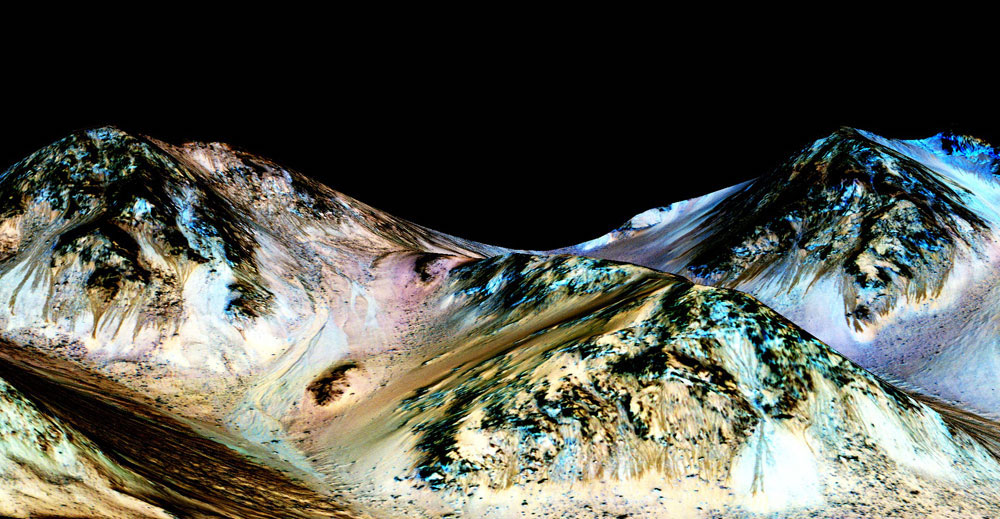Mars H2O: How Scientists Discovered Salty Water on the Red Planet

This week's announcement that salty liquid water flows on Mars has reinvigorated debates about whether the Red Planet's environment could support life. But considerably less attention has been paid to the details behind the actual discovery: How, exactly, were scientists able to prove that briny water can be found on Mars?
Scientists announced yesterday (Sept. 28) that dark, narrow streaks that appear on Mars are caused by flowing water. The mysterious streaks were first spotted on the planet in 2011, but it was the chemical signature of the enigmatic lines that helped researchers make their discovery.
An instrument known as a spectrometer aboard the Mars Reconnaissance Orbiter spacecraft was trained on these so-called recurring slope lineae — dark streaks that change with the seasons on Mars — as it orbited the Red Planet. The observations revealed a chemical signature consistent with salty water, according to Amaury Triaud, a postdoctoral researcher at the Centre for Planetary Sciences at the University of Toronto who has studied planets beyond the solar system but was not involved with the new Mars discovery. [In Photos: Is Water Flowing on Mars?]
A spectrometer measures light and splits it into different wavelengths, which can reveal clues about an object's composition because each chemical element has a distinctive signature, or pattern.
The scientists "saw hydrated salt, or salt that was in contact with water and then dried out," Triaud told Live Science.
But where the water came from is still a mystery. Triaud said further observations of these lineae will be required to figure out the salty water's origin. For instance, one hypothesis is that perhaps the water leached from permafrost (permanently frozen ground) in the soil, or maybe it condensed somehow from the atmosphere, he said.
"What they want to do now is systematically observe those locations from orbit and try to see their patterns," Triaud said. "They will look at the south-facing or north-facing craters, depending on the height and the latitude on the planet, and try to see if there is a relation."
Get the world’s most fascinating discoveries delivered straight to your inbox.
Flowing water on the surface of Mars without salt is impossible, because the planet's atmosphere is so thin, and the surface is so cold, that water sublimates, meaning it passes directly from a solid state (ice) to a gas. Salty water, however, has a lower freezing point and survives longer, Triaud said.
Scientists had suspected for years that the lineae seen on Martian slopes were somehow formed by water, because they appeared darker in the summertime on Mars and less prominent in the winter. This idea is consistent with water that flows when the surrounding environment is warmer, and then dissipates as the temperature cools.
Although NASA has a new Mars rover mission, dubbed Mars 2020, targeted to leave Earth in five years, it's unlikely that the rover could be placed near the lineae for a closer look, Triaud said. The slopes would be too steep for a rover to navigate, the landing area would be too narrow (just a few dozen square meters) and the presence of water could indicate the existence of microbial life, raising concerns about the possibility of contaminating the site with microbes from Earth.
Nonetheless, Triaud said a rover could theoretically take pictures of these features from a distance in a safer, flatter spot — at the bottom of the hill, for example.
He added that it's difficult to say how long these lineae have been flowing on Mars because water tends to erase any craters that are typically used to estimate the age of a planetary surface. Triaud said he wouldn't be surprised if water had been flowing on Mars for many years, or if the dark streaks were even more common a few million years or so ago, when Mars had more water on its surface.
Several billion years ago, Mars was a wetter planet, but as its atmosphere thinned, most of the water evaporated. NASA's Curiosity, Spirit and Opportunity rovers have all found evidence of ancient rocks formed in water. The Curiosity rover, which is still exploring the Martian surface, also found a streamlike feature shortly after it landed on the Red Planet in 2012.
Another NASA mission called MAVEN (short for the Mars Atmosphere and Volatile Evolution) mission is examining present-day atmospheric loss to better understand how and why Mars lost its thick atmosphere.
Follow Live Science @livescience, Facebook & Google+. Original article on Live Science.

Elizabeth Howell was staff reporter at Space.com between 2022 and 2024 and a regular contributor to Live Science and Space.com between 2012 and 2022. Elizabeth's reporting includes multiple exclusives with the White House, speaking several times with the International Space Station, witnessing five human spaceflight launches on two continents, flying parabolic, working inside a spacesuit, and participating in a simulated Mars mission. Her latest book, "Why Am I Taller?" (ECW Press, 2022) is co-written with astronaut Dave Williams.


